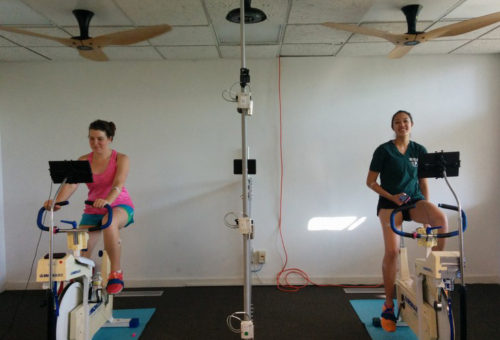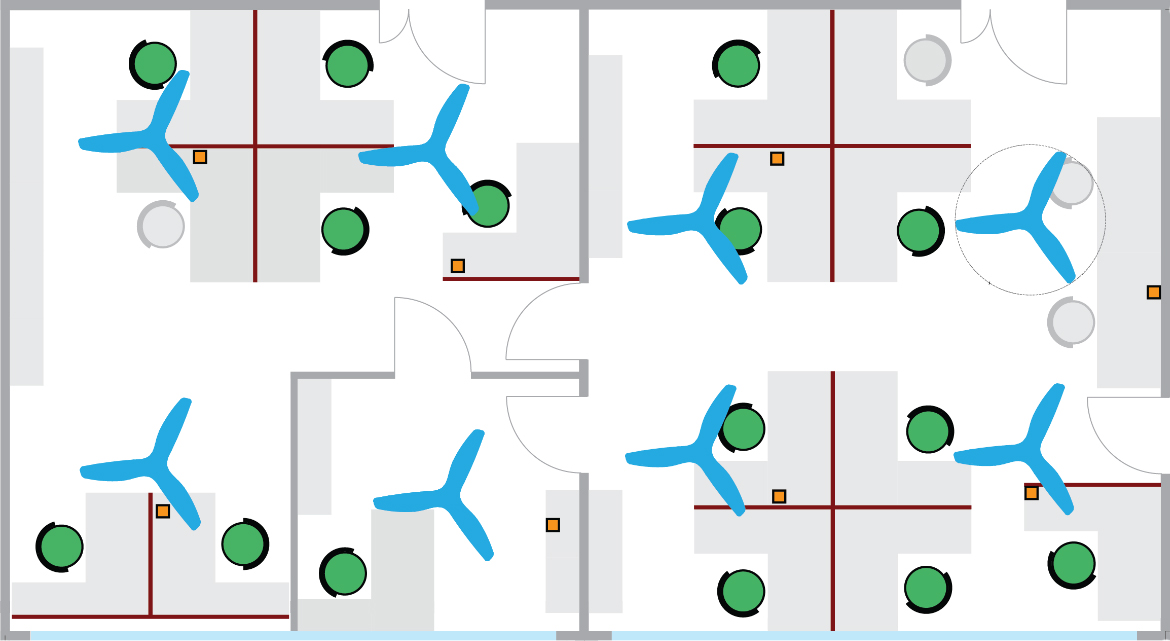It’s exciting when we have the opportunity to experience new sustainable buildings first hand. Last week, while attending the CHESC conference at UC Santa Barbara, along with other attendees I stayed in newly completed student housing designed to meet LEED Platinum standards. While these attractive new buildings exhibit many sustainable features, at times the natural ventilation scheme was not sufficient to maintain comfortable conditions, especially when it was necessary to lower blinds for privacy, or to close windows to block noise from the street and some late night volleyball games.
However, a simple and cost-effective addition to these units would have kept us all comfortable: ceiling fans. CBE research has quantified what we all know intuitively, that fans can provide acceptable comfort at temperatures that otherwise would be stifling. This enables passive solutions in milder climates, and may reduce the reliance on air conditioning in climates where passive solutions alone are not sufficient.
Reducing reliance on air conditioning will be increasingly important due to expected population growth in countries in tropical climates. It is predicted that 60 percent of the world’s population will live in these countries by 2060, up from 40 percent in 2008. This shift, along with economic growth in tropical countries, could lead to a dramatic increase in the number of air conditioning systems in use in coming decades. The International Energy Agency (IEA) has predicted that as many as four billion additional air conditioning units are expected to be in use by 2050, equal to ten new new units being sold every second for the next thirty years.
Already we know that commercial buildings in the U.S. and in tropical climates are frequently over-cooled, making people uncomfortable and wasting energy. This problem can be solved by increasing the temperature and, when needed, increasing air movement with fans. To demonstrate this idea, CBE recently collaborated on a recent study in an actual Singapore office space. The standard temperature of an air-conditioned office building in Singapore is a cool 73°F (23°C). Researchers tested for occupant comfort and self-reported productivity at this standard temperature, then compared the results against a series of tests at higher temperatures — 79 °F (26 °C) and 81°F (27°C) — with shared occupant-controlled ceiling fans.

A study of comfort at high metabolic rates found that ceiling fans would be a low energy solution for fitness centers.
The results are very promising. Occupant satisfaction with thermal comfort was highest in the two warmer conditions with ceiling fans, with no change in perceived productivity, concentration or alertness. The cooler temperatures also require significantly more energy to maintain than the warmer temperatures, even with the energy for ceiling fans factored in. A related study conducted with subjects in a controlled laboratory environment under similar temperatures, found that subjects performed better on some cognitive performance tests at 79°F (26°C) with a fan, than at the standard cooler temperature with no fan.
In addition to office environments, CBE has studied the potential for fans to improve energy use and comfort in fitness centers. These spaces may be energy intensive and are growing in number as they are seen as part of a healthy lifestyle. While most thermal comfort research has looked at sedentary activity in offices, CBE’s study of thermal comfort with exercising subjects was one of the first to delve into this question. The research subjects rode exercise bikes (ergometers) at varying levels of exertion (2, 4 and 6 MET) and at four temperatures from 68°F (20°C) to 79°F (26°C), with occupant controlled ceiling fans. As might be expected, as levels of exertion increased, the subjects adjusted fans for higher airspeeds, up to the maximum setting. With the highest level of exertion, most of the subjects were comfortable with the ceiling fans across the entire range of temperatures tested.
Taken together, along with previous studies that supported the adoption of new thermal comfort standards for air movement, these research findings demonstrate the opportunity for using fans increased occupant satisfaction and comfort, all while reducing energy consumption and greenhouse gas emissions. Building on this work, CBE’s research team is currently conducting a multi-year study to integrate communicating thermostats with smart ceiling fans with a focus on multi-family residential buildings. Our goal for this work is to demonstrate energy savings and improved comfort from this combination, provide design guidance, and identify market barriers to adoption.
Credits: Katelyn Larson contributed to this article. Top image shows plan of Singapore office field study site.

